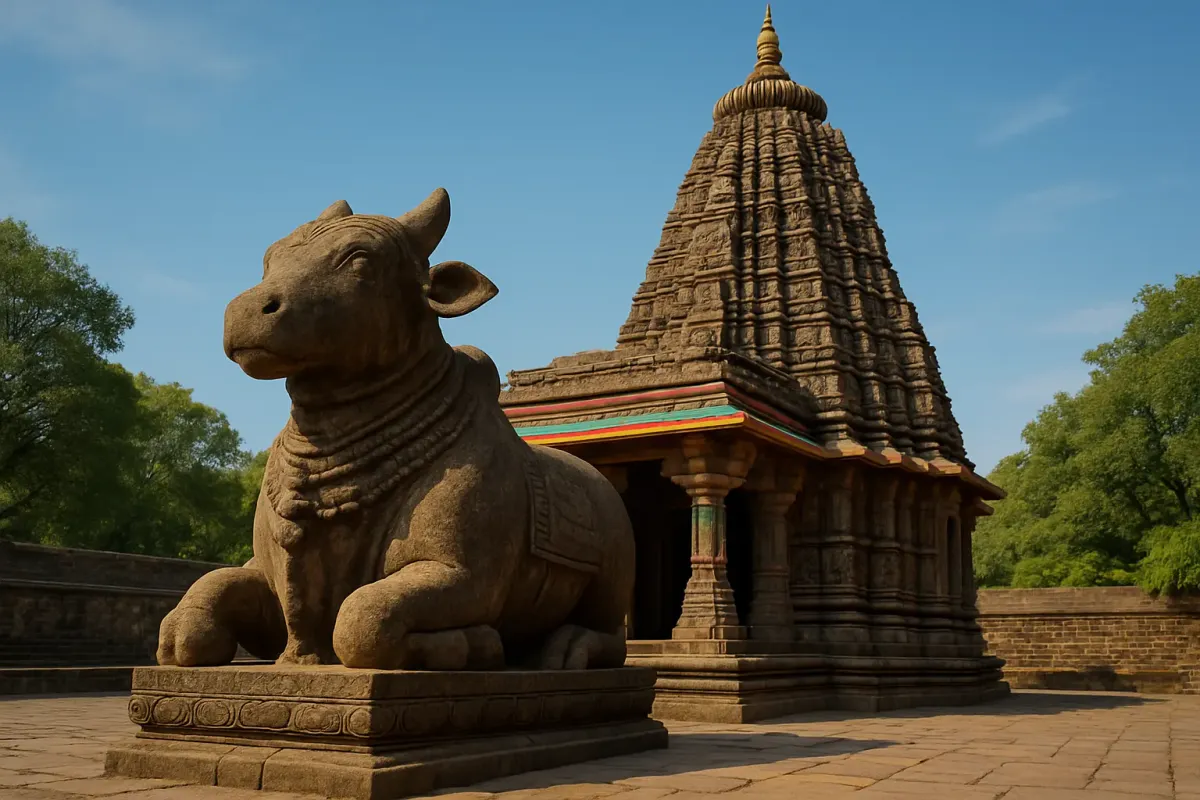Ultimate Guide to Ambernath Shiva Temple: History, Significance, and Visitor Tips 🌟
Explore the Ambernath Shiva Temple, an 11th-century marvel near Mumbai. Learn its history, architecture, festivals, and visitor tips for a divine experience. 🕉️

The Ambernath Shiva Temple, also known as the Ambreshwar Shiva Temple or Puratana Shivalaya, stands as a testament to India’s rich spiritual and architectural heritage. Located in Ambernath, a bustling suburb in Maharashtra’s Thane district, this 11th-century temple is dedicated to Lord Shiva and attracts thousands of devotees and tourists annually. Renowned for its intricate stone carvings and unique Bhumija architecture, the Ambernath Shiva Temple is a hidden gem just 50 km from Mumbai. This guide delves into the temple’s fascinating history, cultural and spiritual significance, and practical information for visitors, making it an essential resource for anyone eager to experience the divine aura of the Ambernath Shiva Temple. Whether you’re a Shiva devotee or a curious traveler, this article will inspire your visit! 🙏
Historical Background of Ambernath Shiva Temple 📜
The Ambernath Shiva Temple is a historic masterpiece built around 1060 AD during the Shilahara dynasty’s reign. Historians attribute its construction to King Chhittaraja, though some suggest his son, Mummuni, may have rebuilt or renovated it. The temple’s inscriptions, particularly on the north-facing door, confirm its Shilahara origins, marking it as a significant cultural artifact from the 11th century.
A captivating legend links the Ambernath Shiva Temple to the Pandavas from the Mahabharata. Local lore suggests that the Pandavas, during their exile, constructed the temple in a single night using a massive stone. Fearing pursuit by the Kauravas, they left the structure incomplete, which explains the temple’s absent shikhara (spire) above the garbhagriha (sanctum). This unfinished aspect has earned the temple the name “Ambreshwar,” meaning “Lord of the Sky,” as the sanctum remains open to the heavens. The town of Ambernath, meaning “Sky Lord,” likely derives its name from this unique feature.
Archaeological findings, including pottery and artifacts, indicate that the Ambernath Shiva Temple site was inhabited as early as 200 BC, underscoring its ancient roots. Rediscovered in 1850 by the Archaeological Survey of India (ASI), the temple has since been recognized for its historical and cultural value, with ongoing efforts to preserve it as a UNESCO World Heritage candidate.
Architectural Brilliance of Ambernath Shiva Temple 🏛️
The Ambernath Shiva Temple is a stunning example of Bhumija architecture, a style prevalent in the Deccan region during the 11th century. Its intricate stone carvings and unique design make it comparable to the Udayesvara Temple in Madhya Pradesh and the Gondeshwar Temple in Sinnar. Here are key architectural highlights:
- Unique Sanctum Design: Unlike typical temples, the garbhagriha is located below ground, accessible by descending 20 steps from the mandapa (hall). This subterranean sanctum, housing a swayambhu (self-manifested) linga, is open to the sky due to the incomplete shikhara.
- Intricate Carvings: The temple’s inner and outer walls are adorned with exquisite reliefs of Hindu deities, including Shiva, Vishnu, Brahma, and Surya. Notably, eight Brahma sculptures on the outer walls suggest the temple was built before Brahma worship declined in the 7th century.
- Hemadpanthi Influence: The Ambernath Shiva Temple reflects the Hemadpanthi style, characterized by precise stonework and diagonal layouts. The square garbhagriha and mandapa are uniquely aligned diagonally, possibly to preserve the swayambhu linga’s position.
- Nandi Statues: Two Nandi (bull) sculptures guard the main entrance, a rare feature in Shiva temples, symbolizing devotion to Lord Shiva.
- Surrounding Landscape: Situated on the banks of the Waldhuni River, the Ambernath Shiva Temple is surrounded by mango and tamarind trees, enhancing its serene ambiance. A nearby kund (water tank) with a hot water stream adds to the site’s mystique.
Despite its age, the Ambernath Shiva Temple has withstood centuries of weathering, though it requires better maintenance to preserve its glory. In 2023, the Maharashtra government allocated ₹138.21 crore for its beautification, including repairs, black stone restoration, and infrastructure upgrades like parking and an exhibition center.
Spiritual Significance of Ambernath Shiva Temple 🕉️
The Ambernath Shiva Temple holds immense spiritual importance for Shiva devotees, often compared to other revered Shiva Temples in India. Its swayambhu linga and ancient origins make it a potent site for worship and meditation. Key spiritual aspects include:
- Mahashivratri Celebrations: The Ambernath Shiva Temple comes alive during Mahashivratri, a major festival dedicated to Lord Shiva. A four-day fair, starting two days before and ending a day after Mahashivratri, attracts thousands of devotees. The temple is crowded with worshippers seeking blessings, and the evening aarti is a divine experience.
- Shravani Somvar: Mondays during the Shravan month are particularly auspicious, with devotees flocking to the Ambernath Shiva Temple for special pujas and abhishekam (ritual bathing of the linga).
- Mythological Connection: The Pandava legend adds a layer of spiritual intrigue, making the Ambernath Shiva Temple a pilgrimage site for those inspired by the Mahabharata.
- Serene Ambiance: The temple’s tranquil setting, enhanced by the Waldhuni River and surrounding greenery, offers a peaceful retreat for prayer and reflection. Visitors often describe a profound sense of divinity in the garbhagriha.
The Ambernath Shiva Temple is also celebrated in the context of Ancient Festivals of India, where its Mahashivratri fair is a vibrant expression of India’s cultural heritage.
Visitor Information for Ambernath Shiva Temple 🚉
Planning a visit to the Ambernath Shiva Temple? Here’s everything you need to know for a seamless experience:
Location and Accessibility 📍
- Address: Ambernath Shiva Temple, Prakash Nagar, Shiv Mandir Road, Ambernath East, Thane, Maharashtra 421501.
- Distance: Approximately 50 km from Mumbai and 2 km from Ambernath Railway Station (East).
- How to Reach:
- By Train: Take a Central Railway train from Mumbai CST, Dadar, or Kalyan to Ambernath Station. From there, the temple is a 2.3 km walk or a short auto-rickshaw ride (₹40-50).
- By Road: Drive via NH61 or take a bus to Ambernath. Autos and taxis are available from Kalyan or Ulhasnagar.
- Nearest Airport: Chhatrapati Shivaji Maharaj International Airport, Mumbai (39 km away).
Timings and Entry 🕒
- Temple Timings: 6:00 AM to 8:00 PM daily.
- Entry Fee: Free entry for all visitors.
- Prasad Timings: Prasad is served daily from 12:00 PM to 2:00 PM.
Best Time to Visit 🌤️
- October to March: Pleasant weather makes it ideal for exploring the Ambernath Shiva Temple.
- Mahashivratri (February/March): Experience the vibrant festival, but expect crowds.
- Weekdays (except Monday): Less crowded for a peaceful visit. Mondays and Shravan Somvar are busy due to Shiva worship.
Tips for Visitors 🧳
- Dress Code: Wear modest clothing, as the Ambernath Shiva Temple is a sacred site. Remove footwear before entering.
- Photography: Cameras are not allowed inside the temple premises to preserve its sanctity.
- Parking: Limited parking is available, and finding a spot can be challenging during festivals.
- Cleanliness: Help maintain the temple’s cleanliness, as some reviews note litter in the surroundings.
- Guides: Local guides may be available to explain the temple’s history and architecture, but verify their credentials.
Nearby Attractions 🗺️
- Ulhas Valley: A scenic spot for nature lovers, 5 km from the Ambernath Shiva Temple.
- Kala Talao Lake: A serene lake in Kalyan, 10 km away.
- Malanggad Fort: A historic hill fort 20 km away, ideal for trekkers.
- Chanderi Fort: A trekking destination in Badlapur, 15 km away.
Challenges and Preservation Efforts 🛠️
Despite its grandeur, the Ambernath Shiva Temple faces maintenance challenges. Visitors have noted issues like poor lighting, unclean surroundings, and incomplete preservation. The temple’s stone carvings, exposed to weather for centuries, require urgent care to prevent further deterioration.
In 2023, the Maharashtra government, in collaboration with the Archaeological Survey of India (ASI) and the National Monument Authority (NMA), approved a ₹138.21 crore beautification project. This includes:
- Restoration of the temple’s black stone structure.
- Infrastructure upgrades like roads, parking, and an amphitheater.
- Enhanced facilities for devotees, such as toilets and an exhibition center.
There are also calls for UNESCO World Heritage status to ensure the Ambernath Shiva Temple is preserved for future generations, recognizing its global cultural significance.
Cultural and Community Impact of Ambernath Shiva Temple 🌍
The Ambernath Shiva Temple is more than a religious site; it’s a cultural landmark that shapes Ambernath’s identity. The temple’s Mahashivratri fair fosters community bonding, attracting devotees from Mumbai, Thane, and beyond. Its historical significance draws scholars and tourists, boosting local tourism.
The temple’s integration into Ambernath’s urban landscape reflects its enduring relevance. Despite modernization, it remains a sacred space for people of all backgrounds, symbolizing India’s spiritual resilience. Efforts to promote Ambernath as a “temple city” highlight the Ambernath Shiva Temple’s role in regional development.
FAQs About Ambernath Shiva Temple ❓
1. What is the Ambernath Shiva Temple?
The Ambernath Shiva Temple is an 11th-century Hindu temple dedicated to Lord Shiva, located in Ambernath, Maharashtra, known for its Bhumija architecture and historical significance.
2. Who built the Ambernath Shiva Temple?
Historians attribute the Ambernath Shiva Temple to King Chhittaraja of the Shilahara dynasty, with possible renovations by his son Mummuni around 1060 AD. A legend also links it to the Pandavas.
3. Why is the Ambernath Shiva Temple unique?
The Ambernath Shiva Temple features a below-ground garbhagriha, open to the sky due to an incomplete shikhara, and intricate stone carvings, making it a rare architectural marvel.
4. When is the best time to visit the Ambernath Shiva Temple?
Visit the Ambernath Shiva Temple from October to March for pleasant weather, or during Mahashivratri for a festive experience, though it’s crowded.
5. How can I reach the Ambernath Shiva Temple?
Take a Central Railway train to Ambernath Station (East), then walk 2.3 km or take an auto-rickshaw to the Ambernath Shiva Temple. It’s 50 km from Mumbai by road.
6. Is photography allowed at the Ambernath Shiva Temple?
No, cameras are prohibited inside the Ambernath Shiva Temple to maintain its sanctity.
Conclusion
The Ambernath Shiva Temple is a divine blend of history, spirituality, and architectural splendor, offering a profound experience for visitors. Its 11th-century origins, intricate Bhumija design, and spiritual significance make it a must-visit destination near Mumbai. Whether you seek Lord Shiva’s blessings, admire ancient craftsmanship, or explore India’s cultural heritage, the Ambernath Shiva Temple will leave you enchanted. Plan your visit to this sacred site, immerse yourself in its serene ambiance, and witness its vibrant Ancient Festivals of India like Mahashivratri. Discover the temple’s legacy among other Shiva Temples in India and experience the divine at the Ambernath Shiva Temple! 🕉️





